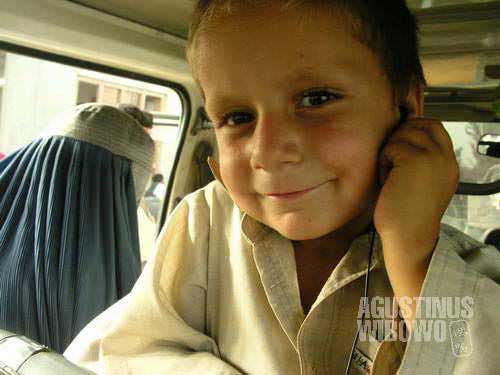Faizabad – The Journey to Badakhshan
“Taliban never came here”
The vehicles taking the passengers from Taloqan to Badakhshan were already busy in the bus depot as early as 5 a.m. in the morning. There were many different types of cars, from the cheapest Falancoach until the costly Volvo. I chose the Falancoach coaster. But I didn’t come quite early, as passengers started to be scarce after 5:30. It was not until 7 the driver successfully collected the passengers to fill up his car and started to depart.
I sat on the third line of the seats in a coaster which was supposed to carry 14 passengers, but was overloaded by 18. In front of me, there were two women under burqas. Apparently the younger, slimmer one was the daughter of the older one. When I came to my seat, they were already there, busy with three young kids. There was also another boy sitting next to them, obviously, their relative, as it’s forbidden in Afghanistan for non related male to sit next to female passengers.
The ladies and children were surprised when I entered the car, simply because I was foreigner. The old lady didn’t cover her face with the burqa, but the younger one never removed the front part of that blue veil so I have never had any idea how she looked like. But they started conversation with me, asking where I was from, where I was going, and with whom I was traveling. All in Farsi. After some months in Pakistan and Afghanistan, interaction with women like this made me very nervous. I was actually surprised that they started conversation with me, a male.
Later, I learnt about the relationship between them. The old bearded man on the front seat next to the driver was the father, and the old woman in uncovered burqa was the mother. The younger woman fully covered in burqa was the daughter, and so was the 14 year old boy, Faridullah. There were two twins, of 2 years old, Najiba (girl) and Najibullah (boy), the children of the old woman. Najiba at two years old had been an auntie, as her sister-in-burqa had a baby already. In Afghanistan it’s very common that boys’ names include the name of God, Allah, shown by the ending of –ullah in the names.
Actually my nervousness was not necessary. The two ladies also talked with the male passengers next to me, and sometimes they shared drink and fruits during the journey. The burqa, veil, didn’t prevent them from interaction with stranger males. And they were also involved in political and religious discussion with other male passengers (most of the time the males talked and the women listened). The old man with beard, the big father, didn’t show any disapproval, nevertheless.
The family is a Tajik family from a northern province of Afghanistan and held strongly the tradition. It was not clear yet for me how burqa came to Afghan culture. The Afghan Pashtuns and Pakistani Pathans, both of the same ethnic, shared the tradition of burqas. But the Afghan Uzbek and Afghan Tajik found that their compatriots in Uzbekistan and Tajikistan, highly influenced by Russian culture, were all unveiled. The Hazara women, the Mongoloid people from Central Afghanistan, also wear burqa, even though in much less strictness and proportion as here in the northeast provinces.
For the women in my car, the burqa didn’t prevent them from the interaction with other males. It was the tradition (and people believed it was religious) not to show women’s face to other males. The tradition was very strong here. The old lady always removed the cover of her burqa, apparently because of the hot weather, so I saw her fat face sweating hard. But she was always reminded by her son, and sometimes by other passengers, to cover her face when the car passed through villages, to prevent her face to be seen by the male pedestrians on village roads.
Certainly, it was not Taliban who brought burqa to the northeast. “Taliban has never come here,” said Dr Momin Jalali from Faizabad, the capital of Badakhshan province. The mountainous terrain of the province had limited its interaction with other parts of the country, making it one of the least accessible areas of Afghanistan. It was the mountains, unpassable hindrance, which protected the area from invaders, as well as limited its development. The mere 177 km distance from Taloqan to Faizabad had to be covered in 12 hours, with average speed less than 20 km/hr. The remoteness of Badakhshan prevented the outer influence to diffuse with the local customs and beliefs.
Badakhshan is hungry. All the way I saw convoy of World Food Program (WFP) trucks bringing the food from lowlands, passing through the high mountains, to the starving people. Some of the trucks even came from Peshawar, Pakistan. Dr Momin, the provincial health director, mentioned several districts where people were severely starving. The distribution of food in the province was also part of his responsibility.
The remoteness of Badakhshan was still the only reason of its today.





Leave a comment